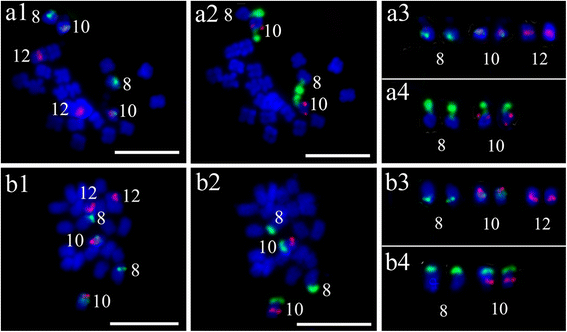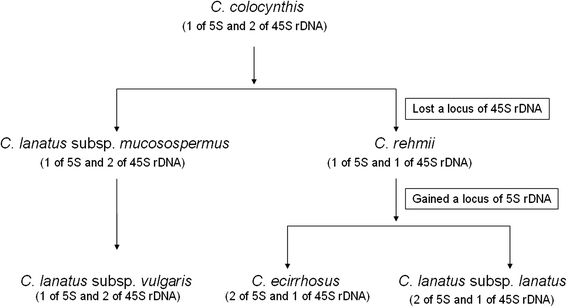Cytogenetic relationships among Citrullus species in comparison with some genera of the tribe Benincaseae (Cucurbitaceae) as inferred from rDNA distribution patterns
- PMID: 27090090
- PMCID: PMC4835933
- DOI: 10.1186/s12862-016-0656-6
Cytogenetic relationships among Citrullus species in comparison with some genera of the tribe Benincaseae (Cucurbitaceae) as inferred from rDNA distribution patterns
Abstract
Background: Comparative mapping of 5S and 45S rDNA by fluorescent in situ hybridization (FISH) technique is an excellent tool to determine cytogenetic relationships among closely related species.
Results: In this study, the number and position of 5S and 45S rDNA loci in all Citrullus species and subspecies were determined. The cultivated watermelon (C. lanatus subsp. vulgaris), C. lanatus subsp. mucosospermus, C. colocynthis and C. naudinianus (or Acanthosicyos naudinianus) had two 45S rDNA loci and one 5S rDNA locus which was located syntenic to one of the 45S rDNA loci. C. ecirrhosus and C. lanatus subsp. lanatus had one 45S rDNA locus and two 5S rDNA loci, each located on a different chromosome. C. rehmii had one 5S and one 45S rDNA locus positioned on different chromosomes. The distribution of 5S and 45S rDNA in several species belonging to other genera in Benincaseae tribe was also investigated. The distribution pattern of rDNAs showed a great difference among these species.
Conclusions: The present study confirmed evolutionary closeness among cultivated watermelon (C. lanatus subsp. vulgaris), C. lanatus subsp. mucosospermus and C. colocynthis. Our result also supported that C. lanatus subsp. lanatus was not a wild form of the cultivated watermelon instead was a separate crop species. In addition, present cytogenetic analysis suggested that A. naudinianus was more closely related to Cucumis than to Citrullus or Acanthosicyos, but with a unique position and may be a link bridge between the Citrullus and the Cucumis.
Keywords: Citrullus species; Cytogenetic relationship; Fluorescence in situ hybridization; Oligonucleotides probes; rDNA.
Figures




Similar articles
-
Comparative chromosomal localization of 45S and 5S rDNAs and implications for genome evolution in Cucumis.Genome. 2016 Jul;59(7):449-57. doi: 10.1139/gen-2015-0207. Epub 2016 May 11. Genome. 2016. PMID: 27334092
-
[Comparative analysis of rDNA distribution in metaphase chromosomes of Cucurbitaceae species].Yi Chuan. 2007 May;29(5):614-20. doi: 10.1360/yc-007-0614. Yi Chuan. 2007. PMID: 17548333 Chinese.
-
Divergence between C. melo and African Cucumis Species Identified by Chromosome Painting and rDNA Distribution Pattern.Cytogenet Genome Res. 2016;150(2):150-155. doi: 10.1159/000453520. Epub 2016 Dec 22. Cytogenet Genome Res. 2016. PMID: 28002819
-
Genetic Resources and Vulnerabilities of Major Cucurbit Crops.Genes (Basel). 2021 Aug 7;12(8):1222. doi: 10.3390/genes12081222. Genes (Basel). 2021. PMID: 34440396 Free PMC article. Review.
-
Anti-Influenza Virus Activity of Citrullus lanatus var. citroides as a Functional Food: A Review.Foods. 2023 Oct 22;12(20):3866. doi: 10.3390/foods12203866. Foods. 2023. PMID: 37893759 Free PMC article. Review.
Cited by
-
Karyotype and Phylogenetic Relationship Analysis of Five Varieties and Cultivars of Zanthoxylum armatum Based on Oligo-FISH.Genes (Basel). 2023 Jul 17;14(7):1459. doi: 10.3390/genes14071459. Genes (Basel). 2023. PMID: 37510363 Free PMC article.
-
Chromosomal Localization and Diversity Analysis of 5S and 18S Ribosomal DNA in 13 Species from the Genus Ipomoea.Genes (Basel). 2024 Oct 19;15(10):1340. doi: 10.3390/genes15101340. Genes (Basel). 2024. PMID: 39457464 Free PMC article.
-
Karyotypic stability of Fragaria (strawberry) species revealed by cross-species chromosome painting.Chromosome Res. 2021 Dec;29(3-4):285-300. doi: 10.1007/s10577-021-09666-1. Epub 2021 Jun 21. Chromosome Res. 2021. PMID: 34152515
-
High-resolution chromosome painting with repetitive and single-copy oligonucleotides in Arachis species identifies structural rearrangements and genome differentiation.BMC Plant Biol. 2018 Oct 17;18(1):240. doi: 10.1186/s12870-018-1468-1. BMC Plant Biol. 2018. PMID: 30333010 Free PMC article.
-
Five Fabaceae Karyotype and Phylogenetic Relationship Analysis Based on Oligo-FISH for 5S rDNA and (AG3T3)3.Genes (Basel). 2022 Apr 26;13(5):768. doi: 10.3390/genes13050768. Genes (Basel). 2022. PMID: 35627153 Free PMC article.
References
-
- Robinson RW, Decker-Walters DS. Cucurbits. New York: CAB International; 1997.
-
- De Winter B. A new species of Citrullus (Benincaseae) from the Namib Desert, Namibia. Bothalia. 1990;20:209–11. doi: 10.4102/abc.v20i1.900. - DOI
-
- Jeffrey C. Cucurbitaceae. In: Hanelt P, editor. Mansfeld’s encyclopedia of agricultural and horticultural crops. 3. Berlin: Springer; 2001. pp. 1510–57.
-
- Khoshoo TN, Vij P. Biosystematics of Citrullus vulgaris var. fistulosus. Caryologia. 1963;16:541–52.
Publication types
MeSH terms
Substances
LinkOut - more resources
Full Text Sources
Other Literature Sources

